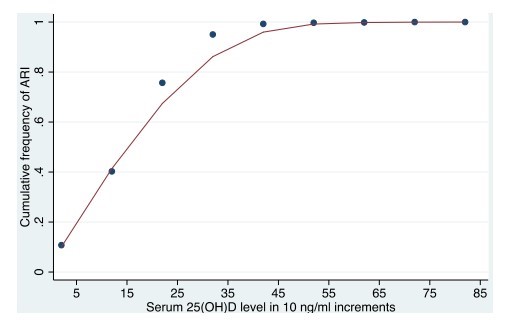Respiratory Infection associated with vitamin D less than 40 ng
Vitamin D Status and Acute Respiratory Infection: Cross Sectional Results from the United States National Health and Nutrition Examination Survey, 2001–2006
Nutrients 2015, 7(3), 1933-1944; doi:10.3390/nu7031933 (registering DOI)
Dominique J. Monlezun 1,2, Edward A. Bittner 3,4, Kenneth B. Christopher 3,5, Carlos A. Camargo Jr. 3,4,6 and Sadeq A. Quraishi 3,4, [email protected]
1 Tulane School of Public Health & Tropical Medicine, New Orleans, LA 70112, USA
2 Tulane University School of Medicine, New Orleans, LA 70112, USA
3 Harvard Medical School, Boston, MA 02115, USA
4 Massachusetts General Hospital, Boston, MA 02114, USA
5 Brigham and Women’s Hospital, Boston, MA 02115, USA
6 Harvard School of Public Health, Boston, MA 02115, USA

Figure 1. Near linear relationship of acute respiratory infection and 25-hydroxyvitamin D up to 30 ng/mL in LOWESS analysis. Locally weighted scatterplot smoothing analysis = LOWESS 25OHD = 25-hydroxyvitamin D in 10 ng/mL increments; ARI = acute respiratory infection.
Vitamin D is a promising, though under-explored, potential modifiable risk factor for acute respiratory infections (ARIs). We sought to investigate the association of vitamin D status with ARI in a large, nationally-representative sample of non-institutionalized individuals from the United States. We analyzed 14,108 individuals over 16 years of age in the National Health and Nutrition Survey (NHANES) 2001–2006 in this cross-sectional study. We used locally weighted scatterplot smoothing (LOWESS) to depict the relationship between increasing 25-hydroxyvitamin D (25OHD) levels and ARI. We then performed a multivariable regression analysis to investigate the association of 25OHD levels with ARI, while adjusting for known confounders. The median serum 25OHD level was 21 (IQR 15–27) ng/mL. Overall, 4.8% (95% CI: 4.5–5.2) of participants reported an ARI within 30 days before their participation in the national survey. LOWESS analysis revealed a near-linear relationship between vitamin D status and the cumulative frequency of ARI up to 25OHD levels around 30 ng/mL. After adjusting for season, demographic factors, and clinical data, 25OHD levels <30 ng/mL were associated with 58% higher odds of ARI (OR 1.58; 95% CI: 1.07–2.33) compared to levels ≥30 ng/mL. Among the 14,108 participants in NHANES 2001–2006, 25OHD levels were inversely associated with ARI. Carefully designed, randomized, controlled trials are warranted to determine the effect of optimizing vitamin D status on the risk of ARI.
Table 1. Overall sample characteristics and sub-groups with acute respiratory infections


📄 Download the PDF from Vitamin D Life
See also Vitamin D Life
Search "Respiratory Tract Infection" 193 items as of March 2015
Breathing category listing has items along with related searches
Upper respiratory tract infection 2X more likely if vitamin D less than 30 ng – Aug 2013
Vitamin D and Respiratory Tract Infections – meta-analysis with charts June 2013
Acute lower respiratory infection 5X more frequent with low vitamin D intake – June 2012
Fewer respiratory infections if optimal level of vitamin D (more than 47 ng) – Sept 2013
Respiratory infections reduced by 63 percent with 4000 IU vitamin D daily - RCT Dec 2012
Acute respiratory infection treated by vitamin D in 6 of 12 clinical trials – review Nov 2012
100 percent of Acute Respiratory Failure patients had low vitamin D - April 2012
Short url =http://is.gd/RespVitD
